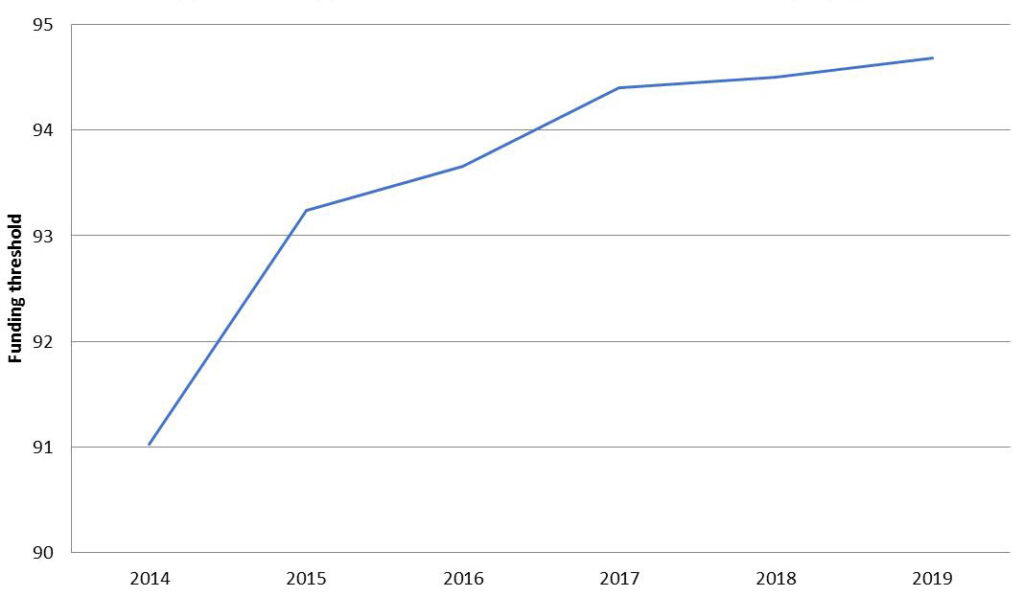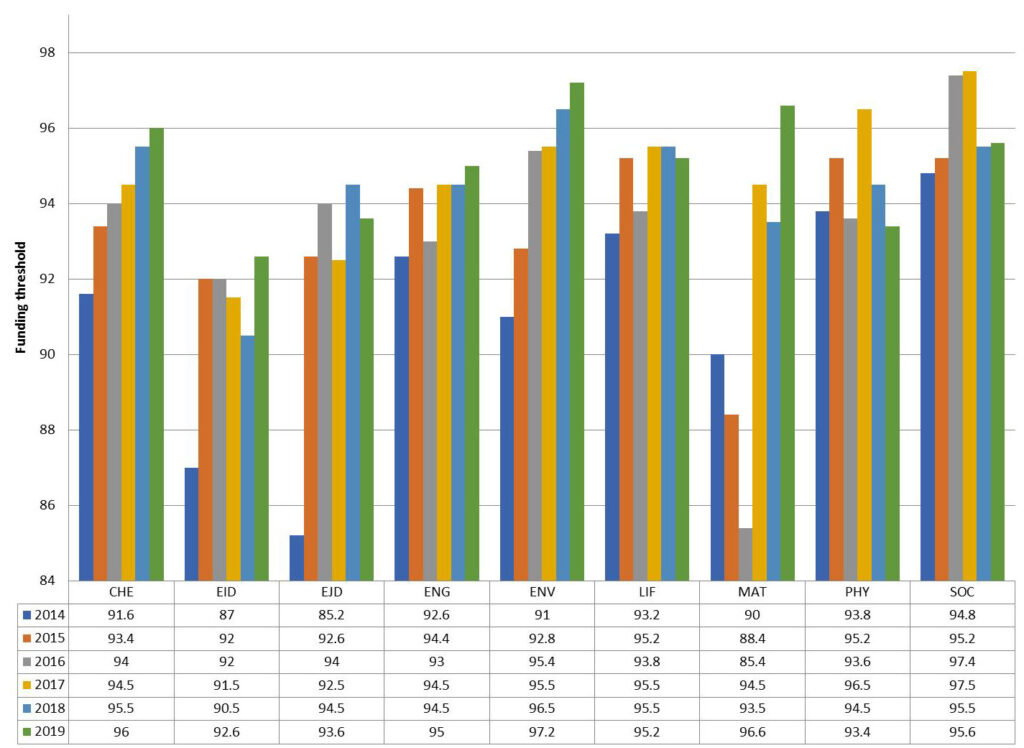Quality matters: trends in successful ITN proposals
29th July 2019 at 2:07 pm
For the past twelve years the European Commission has been supporting thousands of young researchers for doctoral training across Europe. Early Stage Researchers (ESRs), to use these researchers’ official description, are being trained through Marie Skłodowska-Curie Action (MSCA) Innovative Training Networks (ITNs), a longstanding funding scheme of the Horizon 2020 programme. ITNs are a collaboration, also known as training networks, between academic and non-academic (often referred to as simply industry) institutions. Their aim is to train the next generation of leaders in their respective research areas and business sectors as a consortium.
Any consortium looking to obtain funding for an ITN faces fierce competition as the overall success rates have shrunk to 7-8% over the past five years. However, these percentages can vary depending on the individual panels, which represent eight scientific areas, to which an ITN proposal is submitted. This factor is often overlooked by applicants. In this article, we will be looking into each panel to find out which are more competitive than others and how competition has developed over the years. This will be done by measuring the evolution of the so-called cut-off score for funding, i.e. the minimum score above which a proposal will be funded.
What are ITN panels/scientific areas?
Each ETN applicant must choose a panel to which their proposal will be associated as part of the submission process. EIDs and EJDs are evaluated by separate multidisciplinary panels. These Applicants can refine their selection using descriptors which can also cover other disciplines that may be involved. The three evaluating experts, also known as evaluators, will be assigned to proposals based on the panel and descriptors selected. This highlights the importance of perfectly matching the panel and descriptors to the proposal. There are eight panels:
- Chemistry (CHE)
- Social Sciences and Humanities (SOC)
- Economic Sciences (ECO)
- Information Science and Engineering (ENG)
- Environment and Geo-Sciences (ENV)
- Life Sciences (LIF)
- Mathematics (MAT),
- and Physics (PHY).
After an ITN proposal has been submitted and the submission deadline has closed, the evaluation is managed by the Research Executive Agency (REA) with the assistance of the above-mentioned evaluators. The evaluations performed by these experts are on a personal basis. They don’t act as representatives of any entity, be it their country, employer, or any other body. Before any evaluation takes place each expert must declare any known conflicts of interest. The REA staff ensures that a fair process is carried out, in line with the EC’s rules. The REA will also be informed of any conflict of interest that should emerge during the evaluation process. All panels have a chairperson (“chair”) alongside several vice-chairs. All eight panels are managed by REA staff in assistance of the chair and vice-chairs. These don’t evaluate any proposals, their tasks include:
- “finalising the assignment of three experts to each proposal,
- providing guidance to evaluators,
- checking the quality and consistency of the experts’ reports,
- drafting the consensus report,
- attending the panel review meetings to endorse the final ranked lists of proposals for funding.”
Comparing ITN competitiveness within individual panels
We have measured the average funding threshold of ITNs since 2014 in order to illustrate the increasing trends in competition. The graph below represents the minimum score above which a proposal will be funded. We can observe an upward trend going from 91 in 2014 to 94.7 in 2019. This notably means that higher quality and the well-rounded proposal are needed to be evaluated successfully and the trend is further increasing.

However, the results may differ if we observe the trends for each individual panel. Firstly, we notice that the funding range for Chemistry (CHE) and Environment (ENV) kept following an upward trend. In the Engineering (ENG), Life Sciences (LIF) and Mathematics (MAT) panels, we can see that the cut-off scores for funding in 2017-2019 are higher than in previous years. At the same time Physics (PHY) recorded its lowest threshold in 2019 and Social Sciences and Humanities (SOC), after two exceptionally tough years has continued a slight upwards trends in 2018 and 2019.

We can also observe that European Industrial Doctorates (EIDs) usually have lower funding thresholds. However, in the last 2019 call, the EID drew a record-breaking funding threshold of 92.6. Though this has not prevented us from being successful in two EIDs that we supported! Despite the threshold for EJDs going up and down in recent years, the average trend line is pointing upwards.
What we can draw from these figures is that quality matters more than ever, as proposals must reach scores that are close to perfection to secure funding. At accelopment, we are happy to accompany you along the road to perfection with our proven expertise in ITNs.
How accelopment can help your ITN proposal
What started out back in 2008 during the 7th Framework Programme with the Initial Training Networks HEALING, SYSWIND, REFINE and TRAIN-ASAP as well as the NeoGel EID programme, has become a long history of supporting training networks since. Our success has not halted with the transition to Horizon 2020, in which we successfully support the Horizon 2020 ITNs MUSIQ, NanoCarb, PEARRL, STACCATO, LightDyNAmics and ImmerSAFE amongst others. Our role typically starts with the support of the proposal writing process and to help execute the grant preparations with the EC. Then, during the project implementation, we work as a Partner Organisation assisting in project management tasks, coordinating the dissemination activities and/or contributing to the training activities with transferable skills workshops. More details are available on our website.
Sources
Horizon 2020 Guide for Applicants
